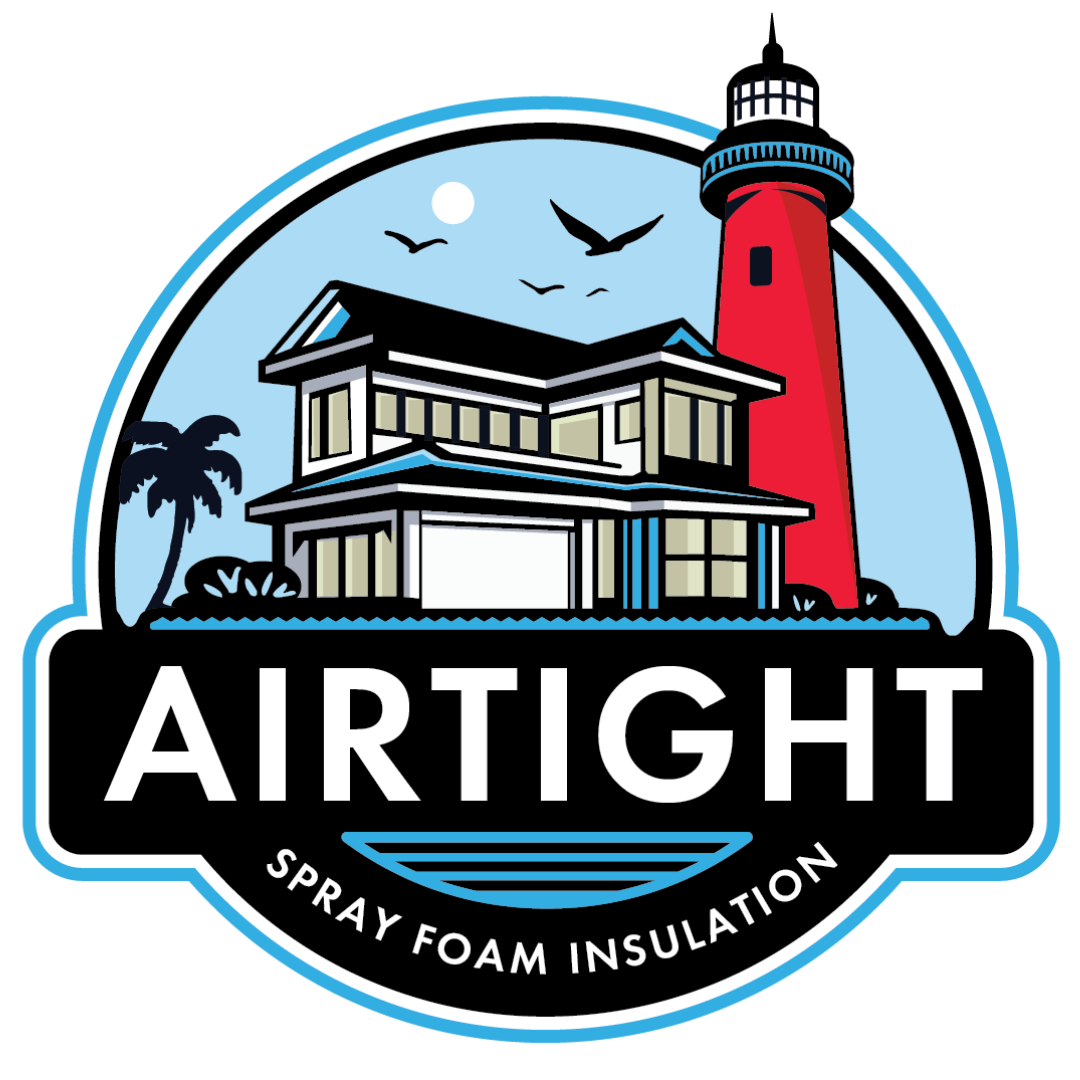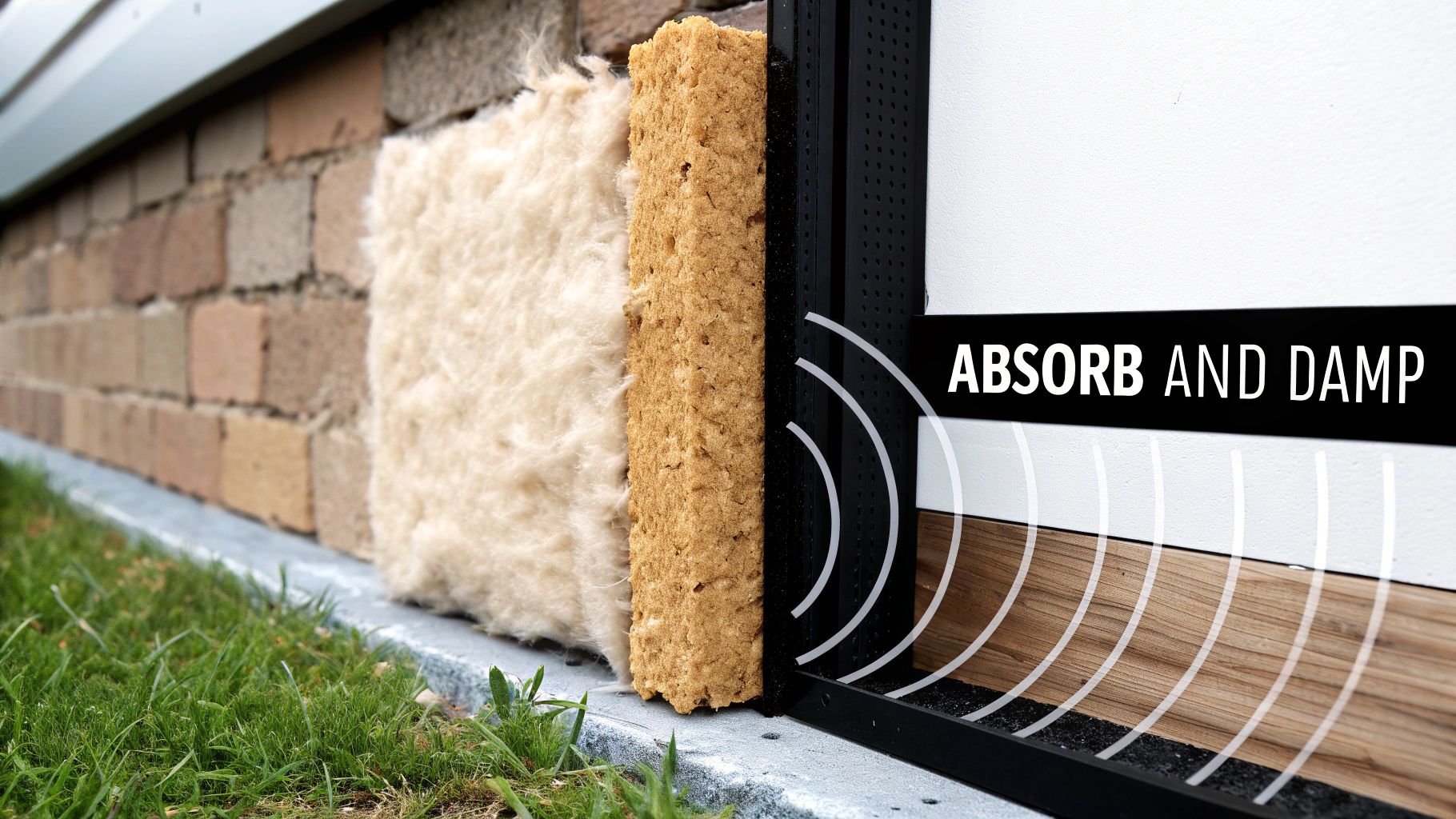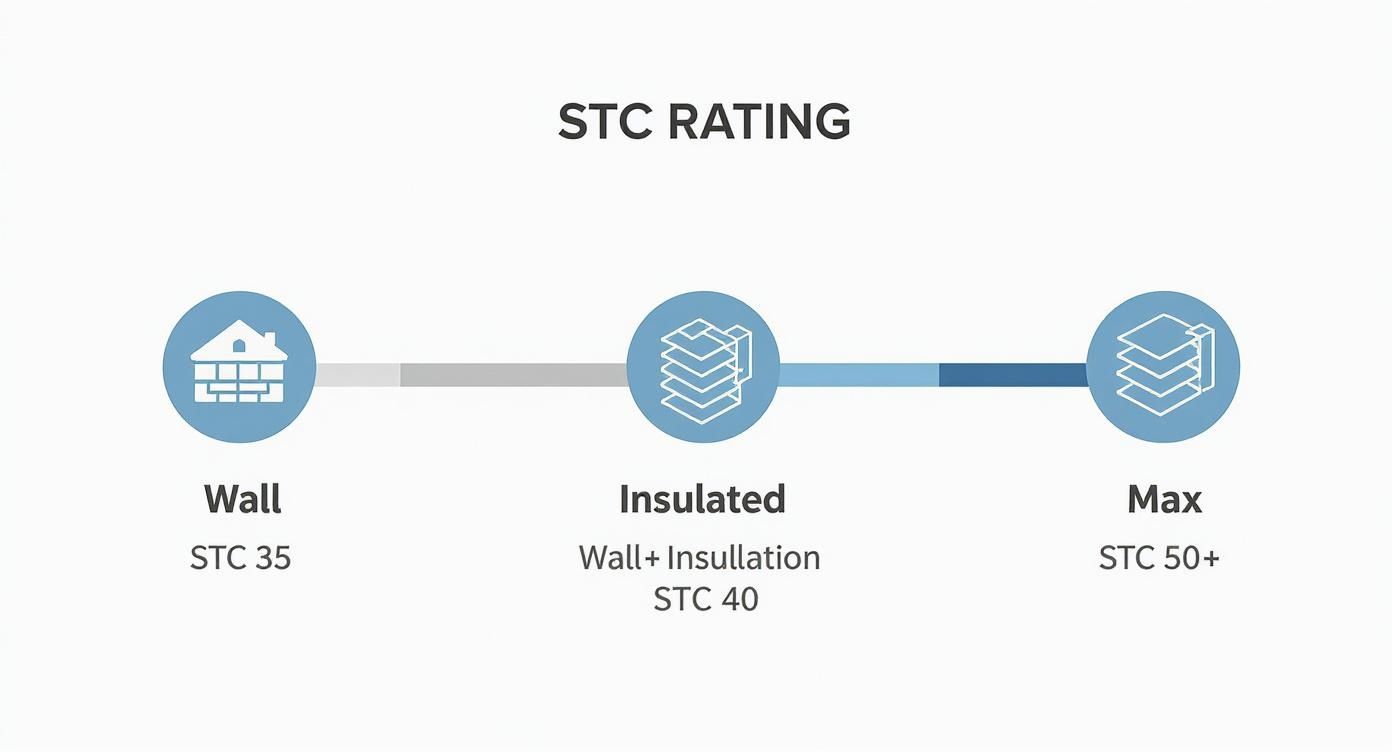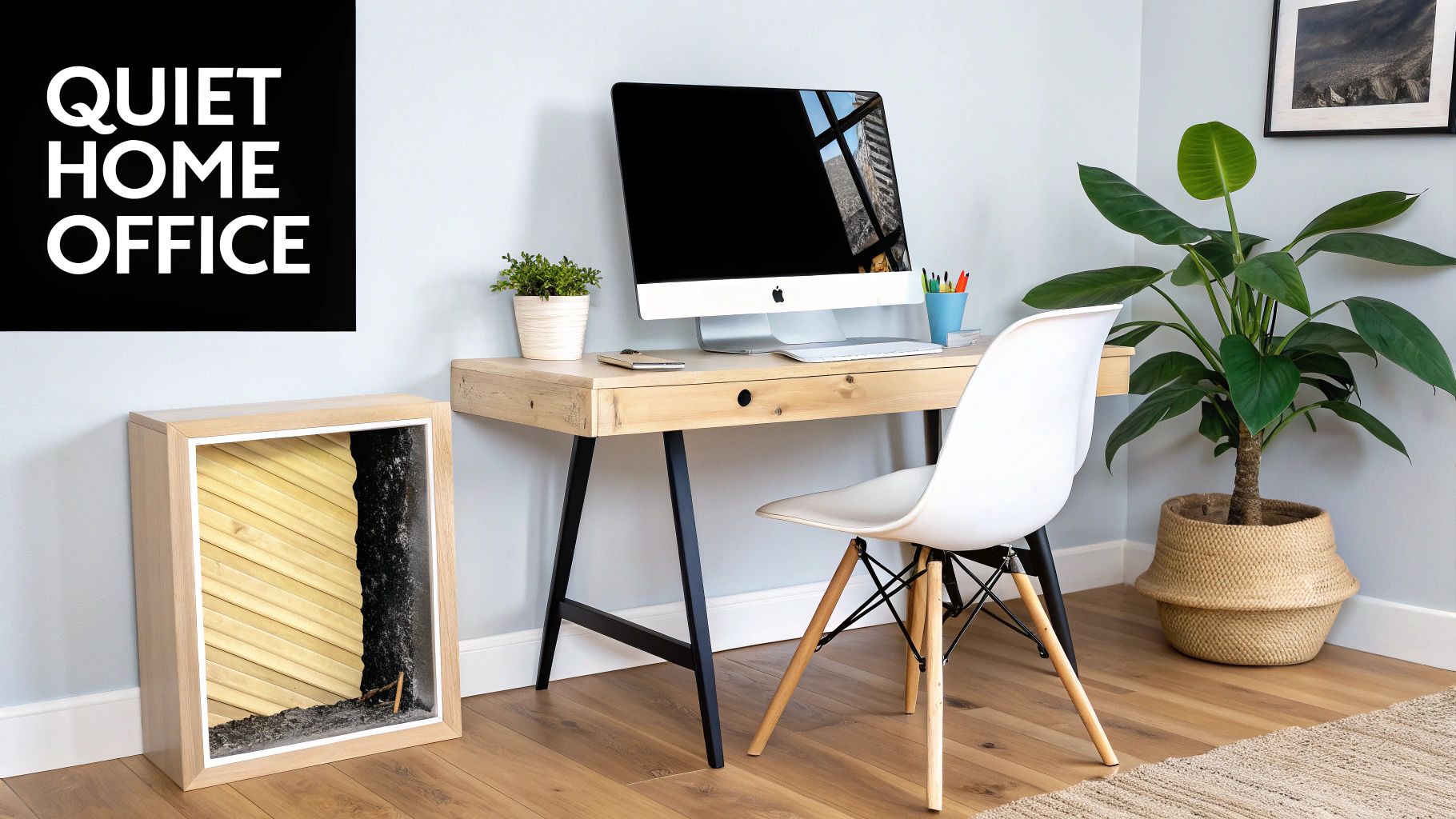Insulation as sound barrier: Explained
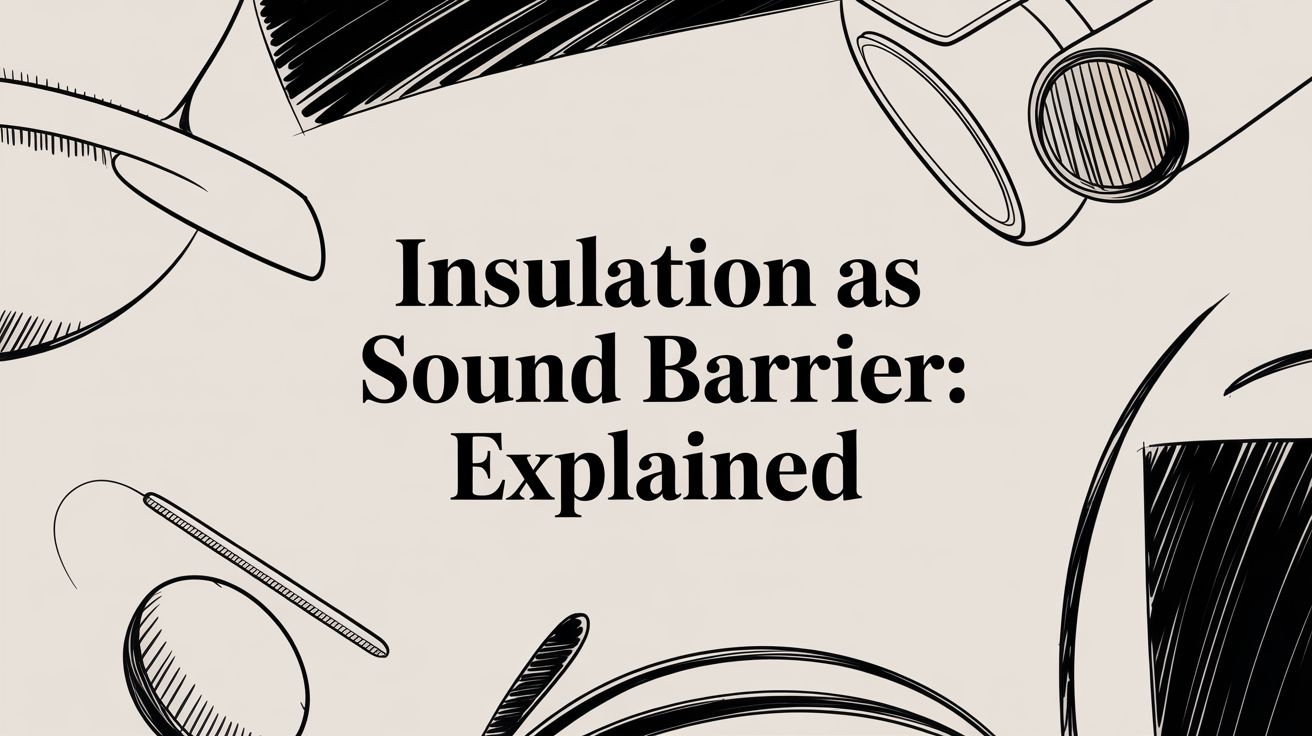
When you think of soundproofing, you might picture thick concrete walls or high-tech studio foam. But one of the most effective tools for quieting your space is actually the insulation hiding inside your walls. Good insulation does more than just block noise; it actively absorbs and dampens sound energy, stopping disruptive sounds before they ever reach your ears.
How Insulation Actually Works as a Sound Barrier
To get a handle on this, think of sound waves like ripples spreading across a pond. When those ripples hit a hard, flat surface—like an uninsulated wall—they just transfer their energy right through to the other side. It’s why you can hear conversations or the TV so clearly from the next room.
An effective insulation as a sound barrier strategy throws a wrench in that process. Instead of a smooth surface, the sound waves run into a complex, messy material filled with tiny pockets and fibers.
This does a few things to disrupt the sound:
Absorption: Materials like open-cell spray foam or mineral wool have a tangled, porous structure. As sound waves travel into this maze, they get trapped, bounce around, and lose energy with every collision. The sound literally runs out of steam.
Dampening: The sheer mass of the insulation makes it harder for the wall itself to vibrate. Think of it like trying to shake a heavy blanket versus a thin sheet. Denser insulation resists the vibrations that carry sound through studs and drywall.
Decoupling: While insulation doesn’t decouple a wall on its own, it’s a critical part of the system. When you build a wall with separated layers (decoupling), the insulation in the gap absorbs any sound that tries to jump from one side to the other.
Two Types of Noise Insulation Tackles
Not all noise is created equal. Insulation works a bit differently depending on what you’re trying to block out.
Airborne Noise: This is anything that travels through the air. Think conversations, barking dogs, or traffic outside. Insulation materials with great absorption qualities are fantastic at soaking up this kind of sound.
Impact (or Structural) Noise: This comes from direct contact with the building’s frame. Footsteps from the floor above, a slamming door, or the rumble of an appliance are all impact noises. Denser, heavier insulation materials are best here, as they dampen the vibrations at the source.
A lot of people think soundproofing is about creating a totally silent, impenetrable box. The reality is much more about strategy—it’s about using the right materials to systematically absorb, dampen, and break up sound waves so very little is left to hear. Insulation is a cornerstone of that strategy.
The best soundproofing solutions attack the problem from multiple angles. For example, adding dense insulation not only adds mass (dampening) but its porous structure also provides absorption. This one-two punch is what turns a standard wall into a truly peaceful barrier.
How Insulation Quiets Your Space
Here's a quick look at the core principles that make insulation such an effective soundproofing tool.
| Principle | How It Works | Common Material |
|---|---|---|
| Absorption | Traps sound waves in a porous structure, converting their energy into tiny amounts of heat. | Open-Cell Spray Foam, Mineral Wool |
| Dampening | Uses mass and density to resist vibration and slow the transfer of sound energy. | Closed-Cell Spray Foam, Dense-Pack Cellulose |
| Decoupling | Creates a physical separation in a structure, which insulation then fills to absorb trapped sound. | Resilient Channels combined with Insulation |
By understanding these concepts, you can see how different types of insulation can be chosen to target specific noise problems in your home or building.
When you start looking into insulation for soundproofing, you’ll quickly run into a couple of acronyms that are basically the report card for how well a material blocks noise. These ratings, STC and IIC, are the industry standard for measuring sound performance. Getting a handle on what they mean is the first step toward getting some actual peace and quiet.
Think of these ratings like the SPF on sunscreen. A bigger number means better protection—in this case, from noise you don’t want to hear.
Cracking the Code on STC for Airborne Noise
The most common rating you’ll see is the Sound Transmission Class (STC). This number tells you how good a wall, ceiling, or floor is at blocking airborne noise. We’re talking about the sounds that travel through the air, like:
Loud conversations or arguments in the next room
The bass from a TV or stereo system
Traffic noise creeping in from outside
A neighbor’s dog barking its head off
The STC rating is just a single number. The higher it is, the more sound gets blocked and the quieter your space will be. For perspective, a standard uninsulated interior wall might have an STC of around 35—you can pretty much make out a whole conversation on the other side. A wall in a luxury hotel, on the other hand, is built to hit an STC of 60 or more, where loud sounds are muffled into a faint murmur, if you hear them at all.
To see how this works in the real world, let's take a standard 2×4 stud wall with 5/8-inch gypsum board on each side. That basic setup has an STC of about 35, which doesn’t do much for privacy. Just by adding insulation into that wall cavity, the rating jumps to 40. If you go a step further and install a resilient channel to separate the drywall from the studs, it climbs to 45. For even better results, throwing on a second layer of 5/8-inch gypsum board can add another 5 to 8 points, getting you to a total between 50 and 53. These little gains show how layering different materials creates a powerful cumulative effect, a strategy often detailed in guides on soundproofing for multi-family builds.
Interpreting IIC for Impact Noise
While STC covers sounds flying through the air, the Impact Insulation Class (IIC) tackles a completely different animal: structural or impact noise. This is the sound of physical thumps and bumps vibrating right through the building’s frame.
IIC ratings are all about thuds, bangs, and bumps. If you’ve ever lived below someone with heavy footsteps or an active kid who loves to jump, you understand impact noise intimately. It's the sound of energy traveling directly through the floor-ceiling assembly.
Common sources of impact noise include:
Footsteps from the floor above
Someone dropping something heavy on the floor
Furniture being dragged across a room
The low rumble of a washing machine on spin cycle
Just like with STC, a higher IIC number means better performance. This rating is especially critical for multi-level homes, apartments, and condos. To get a high IIC score, you need materials that decouple the floor from the ceiling assembly—things like special underlayments or resilient channels combined with sound-absorbing insulation. Using a quality insulation as a sound barrier inside that floor-ceiling cavity is non-negotiable for soaking up the vibrations that create all that racket. Without it, the empty space can act like a drum, making sounds even louder instead of quieting them.
Comparing the Best Insulation Materials for Soundproofing
Picking the right insulation for sound control isn’t a one-size-fits-all deal. It’s about matching the material to the kind of noise you’re trying to silence. Some materials are fantastic at soaking up airborne sound, like a loud conversation, while others add the sheer bulk needed to stop vibrations in their tracks. Getting this difference is the first step toward creating a genuinely peaceful space.
Let’s walk through the most common options—spray foam, fiberglass, mineral wool, and cellulose—to see how they really stack up when it comes to soundproofing.
Spray Foam Insulation: The Dual Threat
Spray foam insulation comes in two main types, and each brings a unique strength to the soundproofing game.
Open-Cell Spray Foam: Picture open-cell foam as a soft, spongy material filled with countless tiny, interconnected air bubbles. This structure is a maze for sound waves. When noise from a TV or conversation hits it, the sound gets trapped, loses its energy, and fizzles out. It's why we love using it for interior walls, home theaters, and offices where echo and chatter are the main culprits.
Closed-Cell Spray Foam: This version is the complete opposite—it's dense, rigid, and hard as a rock. Its superpower in soundproofing is adding serious mass to a structure. That density is what dampens vibrations and blocks those deep, low-frequency sounds, like the rumble from a home theater’s subwoofer or nearby traffic. While it doesn't absorb sound quite like open-cell, its rigidity and ability to create a perfect air seal make it a beast for stopping sound from getting through at all.
Traditional Insulation Choices
Besides spray foam, a few old-school materials have been used for sound control for years, each with its own pros and cons.
Fiberglass Batts
Fiberglass is probably the most common and budget-friendly insulation out there. It works by trapping air between its fine glass fibers, which helps absorb some airborne noise. The problem? It's not very dense, and it’s nearly impossible to install without leaving small gaps and cracks, which become perfect little highways for sound to sneak through.
Mineral Wool (Rock Wool)
Significantly denser than fiberglass, mineral wool packs a one-two punch. Its fibrous makeup is great for absorbing sound, while its heavier weight adds mass to walls and floors to block sound transmission. This makes it a solid all-around performer for soundproofing, though it does come with a higher price tag.
Cellulose Insulation
Made from recycled paper, cellulose is usually blown into wall cavities. When dense-packed, it creates a tight, seamless barrier that's excellent at stopping airborne sound. It flows around pipes and wires beautifully, eliminating the sound leaks you often get with pre-cut batts.
Visualizing the Impact of Insulation
This chart really puts it into perspective, showing how much a wall’s sound-blocking ability (its STC rating) improves just by adding insulation.
As you can see, insulation alone gives you a big boost. When you start combining it with other soundproofing strategies, you can create a seriously quiet room.
Head-to-Head Comparison: Soundproofing Insulation Material Comparison
To help you sort through the options, we've put together a quick comparison table that breaks down the key differences between these materials for soundproofing projects.
| Insulation Type | Primary Soundproofing Method | Best For | Moisture Resistance | Estimated Cost |
|---|---|---|---|---|
| Open-Cell Spray Foam | High Absorption | Interior walls, ceilings, media rooms, reducing echo and airborne noise. | Poor | $$ |
| Closed-Cell Spray Foam | Mass & Dampening | Exterior walls, floors, metal buildings, blocking low-frequency noise. | Excellent | $$$ |
| Mineral Wool | Absorption & Mass | Walls and floors requiring both airborne and impact noise reduction. | Good | $$ |
| Fiberglass Batts | Basic Absorption | Budget-friendly projects for moderate airborne sound reduction. | Poor | $ |
| Cellulose (Dense-Pack) | Absorption & Gap-Filling | Retrofitting existing walls, creating a seamless sound barrier. | Poor | $ |
It’s crucial to understand the difference between sound absorption (soaking up sound like a sponge) and sound blocking (stopping it like a brick wall). Great absorbers like open-cell foam are light and porous. Materials that block sound well are dense and heavy.
For us here in South Florida, moisture resistance is a non-negotiable factor that often makes the decision for you. Materials like fiberglass and cellulose can act like sponges in our humid air, leading to mold and losing their effectiveness. Closed-cell spray foam, on the other hand, is a vapor barrier, offering a superior, long-lasting solution that stands up to our climate.
Ultimately, the best insulation as a sound barrier comes down to your specific goals—the type of noise you’re fighting, your budget, and where you live. For most folks around here, especially given the humidity, the complete air and moisture seal from spray foam makes it an unbeatable investment. If you’re looking at options for your own home, you can find more details on our spray foam insulation in Jupiter, FL to see how we tackle local projects.
Real-World Soundproofing for Your Home
Knowing the science is great, but seeing how an insulation as a sound barrier actually transforms your living space is what really matters. It's about finally getting that quiet home office, silencing the noise from upstairs, and reclaiming a sense of peace.
Let’s get practical and look at where insulation makes the biggest difference.
Quieting Interior Walls for Privacy and Focus
One of the biggest complaints we hear is about noise traveling right through the walls. Thin drywall with an empty space in between does almost nothing to stop conversations, the TV, or music from bleeding into the next room. This is a huge issue for home offices, nurseries, or anyone who just needs a quiet bedroom.
Filling those empty wall cavities completely changes the game.
- For home offices or media rooms, open-cell spray foam is our go-to solution. It expands to fill every single nook and cranny around pipes and wiring, creating a seamless, airtight seal. Its soft, spongy texture is fantastic at soaking up the mid-to-high frequency sounds of voices and entertainment systems. It turns a distracting wall into a quiet backdrop for work or relaxation.
Silencing Noise Between Floors
Impact noise—the thud of footsteps, the scrape of a chair, or kids running around upstairs—is a tough one. That sound energy travels right through the structure of your house, and an empty floor-ceiling cavity can act like a drum, making it even louder.
Insulating the space between the floor joists is the key to breaking that vibration path. Here, you need materials that can dampen or absorb that energy. While closed-cell foam adds mass, open-cell foam also does a great job absorbing the sound that gets trapped in the cavity. This simple step can make a massive difference in the floor's IIC (Impact Insulation Class) rating and give you back your sanity.
The real goal is to "disconnect" the floor above from the ceiling below. Insulation fills the gap, absorbing the sound energy that would otherwise vibrate straight through to the room downstairs.
Blocking Outside Noise with Attics and Ceilings
Your attic is a major gateway for outside noise. Whether it's planes overhead, loud neighbors, or a classic South Florida thunderstorm, an uninsulated attic lets all that sound pour right into your home.
Applying a thick layer of insulation across the attic floor or directly to the underside of the roof deck creates a powerful acoustic shield. Open-cell spray foam is perfect here because it sticks to all the awkward angles of rafters and trusses, leaving zero gaps for sound to sneak through. This doesn't just quiet the whole house—it also delivers huge thermal benefits that cut down your energy bills.
Taming Echo in Metal Buildings
Metal buildings, workshops, and garages are an acoustic nightmare. The hard, flat metal surfaces bounce sound around endlessly, creating a mess of echo and reverberation. Trying to have a conversation is tough, and the noise from machinery can be unbearable.
For these spaces, insulation isn't just a nice-to-have; it's a necessity. Spraying foam directly onto the interior of the metal panels does two critical things at once:
Absorption: The foam's surface immediately soaks up sound waves, killing the echo.
Dampening: It stops the metal panels from vibrating like a drum when hit by rain or wind.
This simple application can turn a loud, booming metal box into a comfortable, functional workspace. The power of a well-designed sound barrier is well-documented, even in massive engineering projects. Studies on soundproof tunnels, for example, show how using the right materials makes all the difference. You can read some interesting findings on different sound barrier types to see just how much material choice matters.
Why South Florida's Climate Demands a Special Approach
Picking an insulation as a sound barrier in South Florida isn't just about acoustics or temperature. Down here, we're fighting a relentless opponent that can wreck a soundproofing project before it even gets off the ground: humidity. Our tropical climate means the air is thick with moisture all year, creating an environment where the wrong insulation can quickly turn into a costly liability.
This constant, high humidity is a direct threat to many common types of insulation. Porous materials like fiberglass and cellulose act like sponges, soaking up airborne moisture. Before long, you're looking at a cascade of problems that completely wipe out your investment in a quieter, more comfortable home.
Once these materials get damp, they lose their fluffiness and ability to trap air—the very thing that makes them work for both thermal control and soundproofing. A soggy batt of fiberglass is worse than useless; it becomes a breeding ground for mold and mildew, introducing serious health hazards right inside your walls and attic.
The Critical Role of Moisture Management
In our neck of the woods, managing moisture isn't just a nice-to-have feature—it's the bedrock of any successful insulation strategy. Simply blocking sound doesn't count for much if the material degrades, rots, or starts growing mold within a few years. Any gaps, sagging, or compression caused by moisture creates a superhighway for both sound and humid air to travel right through your walls.
That's why a material's ability to resist water and act as a vapor barrier is just as important as its STC rating. An insulation that can't stand up to our humidity will eventually fail at everything else, including sound control.
In South Florida, your insulation has to do three jobs flawlessly: control temperature, block sound, and—most importantly—defeat moisture. If it fails at that last one, it's guaranteed to fail at the other two.
Why Closed-Cell Spray Foam Is the Superior Solution
This is where the unique properties of closed-cell spray foam really shine. It doesn't just resist moisture; it's completely impermeable to it. Think of it as a suit of armor for your home.
Here’s how it creates an unbeatable defense in our climate:
It Forms a Rigid Vapor Barrier: Once it cures, closed-cell spray foam becomes a solid, non-porous plastic. It creates an airtight and watertight seal that physically stops moisture in its tracks, protecting your home's structure from rot and decay.
It Maintains Its R-Value and STC Rating: Because it simply can't absorb water, closed-cell foam's thermal and acoustic performance never degrades. It will provide the same sound dampening and energy efficiency on day one as it will decades down the road.
It Adds Structural Strength: Its rigid, dense nature actually adds significant structural integrity to your walls and roof deck—a fantastic bonus, especially when storm season rolls around.
When it comes to the battle against South Florida’s humidity, traditional insulation is often outmatched. Closed-cell spray foam delivers the tough, multi-talented solution you need to make sure your home isn't just quiet and comfortable, but also healthy and durable for years to come.
Your Next Step Toward a Quieter Home with Airtight
If there's one thing to take away from this guide, it's this: choosing the right insulation as a sound barrier is one of the smartest investments you can make for a peaceful home. We've walked through how different materials absorb, dampen, and block noise, and it’s pretty clear why spray foam insulation consistently comes out on top for both acoustics and energy efficiency.
But picking the right material is only half the battle. Flawless installation is just as critical to getting the quiet and comfort you’re after. That’s where real-world expertise makes all the difference.
The Airtight Advantage in South Florida
Here at Airtight Spray Foam Insulation, we do more than just fill wall cavities. We engineer a complete air and sound seal that’s built to handle the unique challenges of the South Florida climate. Our approach is a mix of industry-leading materials and over two decades of hands-on installation experience.
We know that for homeowners here, an insulation solution has to do three jobs at once: fight noise, cut energy costs, and stand up to our relentless humidity. That’s exactly why we specialize in spray foam.
Superior Sound Control: Whether you need the chatter-absorbing qualities of open-cell foam for a home theater or the dense, vibration-killing power of closed-cell foam for exterior walls, we match the product to your specific soundproofing goals.
Unbeatable Moisture Defense: In our humid environment, this is a big one. Closed-cell spray foam creates a solid vapor barrier, protecting your home from the mold, mildew, and rot that plague lesser materials.
Maximum Energy Efficiency: By creating a perfect, gap-free seal, our spray foam solutions stop air leaks cold. Your indoor temperatures stay stable, your HVAC system gets a break, and you see real savings on your monthly energy bills.
Investing in professional spray foam installation isn't just a purchase; it's a long-term upgrade for your property. You gain a quieter, healthier, and more energy-efficient living space that adds tangible value to your home.
Let’s Create Your Quiet Space
Transforming your home from noisy and drafty to quiet and comfortable is more straightforward than you might think. Our process is built on clarity and quality, from the first conversation to the final walkthrough. We’ll give you a detailed plan and a clear estimate so you know exactly what to expect.
When you're ready to stop putting up with unwanted noise and start enjoying the peace you deserve, our team is here to help. Discover the difference a professionally engineered sound barrier can make.
To learn more about what we do and get a personalized plan for your home, visit us at Airtight Spray Foam Insulation and request your free quote today.
Frequently Asked Questions About Insulation and Soundproofing
When people start looking into insulation for sound control, a few key questions always come up. To give you a clear picture, we've put together some straightforward answers based on our years of experience in the field.
Can Soundproofing Insulation Be Added to Existing Walls?
Yes, absolutely. You don't need to tear your house apart just to get some peace and quiet. Modern techniques let us retrofit soundproofing insulation into finished walls with very little mess or disruption.
Methods like blown-in cellulose or injectable spray foam are perfect for this. We simply make a small, precise opening in the drywall, fill the wall cavity completely, and then patch it up. It’s a surprisingly clean and effective way to beef up a room's sound-blocking power without a full-blown renovation.
Will Soundproofing Insulation Also Improve Energy Efficiency?
It sure will. The very things that make insulation great at stopping sound also make it a fantastic thermal barrier. At its core, the job is about trapping air and adding mass within a wall.
That dense, air-trapping structure scrambles sound waves while also slowing down heat transfer. So, when you install effective soundproofing, you’re really solving two problems at once. You get a quieter home and lower energy bills, making it one of the smartest upgrades you can make.
The science behind sound control and thermal control is one and the same. A material that's good at stopping sound energy is naturally good at stopping heat energy. That synergy is what makes soundproofing insulation such a powerful investment.
Is Spray Foam Insulation a Safe Choice for My Family?
This is a great question and one we take very seriously. The answer is a definite yes, but with a critical condition: it must be installed by certified professionals who follow strict safety protocols.
During the application, our trained installers use full protective gear and proper ventilation to manage any fumes. Once spray foam cures—which happens pretty fast—it becomes completely inert and stable. It doesn’t off-gas or release harmful chemicals into your home. A properly installed spray foam system is a safe, permanent, and incredibly effective part of a healthy, comfortable home.
For a deeper dive into materials and techniques, check out the guides on the Airtight Spray Foam Insulationblog.
Ready to turn your home into a quiet, energy-efficient sanctuary? Contact Airtight Spray Foam Insulation for a free, no-obligation quote and find out how our expert solutions can bring peace and comfort to your space. https://airtightsprayfoaminsulation.com
